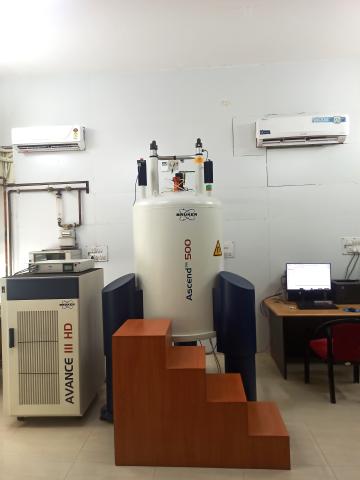
.
Category
- Spectroscopy and Spectrometry » NMR Spectroscopy
Booking Details
Facility Management Team and Location
Facility Features, Working Principle and Specifications
Facility Description
The 500 MHz Bruker AVANCE III HD NMR Spectrometer at the Department of Chemistry, IIT Bombay, is a state-of-the-art analytical instrument designed for advanced research in molecular structure and dynamics. It supports both liquid and solid-state NMR with a range of probes and variable temperature capabilities, catering to diverse academic and industrial applications.
Features
Advanced Probes:
- 5 mm Multinuclear Probe (BBFO): For liquid-state studies of nuclei like 1H, 13C, 19F, 31P, 11B, 27Al, 77Se, 125Te, 199Hg, etc.
- Broadband Solid-State Probe: For MAS experiments with spinning speeds up to 15 KHz.
Experiment Capabilities:
- 1D NMR: Includes 1H, 13C, NOE, APT, DEPT, and others.
- 2D NMR: Experiments like COSY, NOESY, TOCSY, HSQC, HMBC, DOSY, and ROESY.
- Variable Temperature (VT): Experiments in the range of -40°C to +100°C.
Sample Types:
- Liquid Samples: Soluble in 0.6 mL of a suitable solvent.
- Solid Samples: Fine powders (~20 microns) for MAS-NMR.
NMR spectroscopy is based on the magnetic properties of certain atomic nuclei. When placed in a strong external magnetic field, these nuclei absorb and emit radiofrequency energy corresponding to specific nuclear transitions:
- External Magnetic Field Interaction: Nuclei with spin align with or against the field.
- Radiofrequency Energy Absorption: Transitions between energy states occur at specific frequencies.
- Signal Detection and Processing: Emitted signals are processed to generate spectra, revealing structural, dynamic, and environmental information.
- Operating Frequency: 500 MHz for 1H (other nuclei operate at corresponding frequencies).
- Probes:
- Liquid-state: BBFO probe.
- Solid-state: MAS probe with a maximum spinning speed of 15 KHz.
- Temperature Range: -40°C to +100°C (with VT accessory).
Instructions for Registration, Sample Preparation, User Instructions and Precautionary Measures
External Users:
- Submit a letter on your institution's official letterhead, signed by the Head/Guide, stating that the analysis is for research purposes (to qualify for academic concessions).
- Address the letter to: The Head, Department of Chemistry, IIT Bombay.
Include the Following Details:
- Type of analysis required.
- Solvent used.
- Spectral range.
Liquid Samples:
- Ensure complete solubility in 0.6 mL of the selected solvent.
- Required amounts:
- 1H NMR: 10-20 mg (depending on molecular weight).
- 13C NMR: 20-30 mg for adequate signal-to-noise ratio.
Solid Samples (MAS-NMR):
- Prepare as a fine powder (~20 microns).
- Required quantity: 100-200 mg for optimal results.
Before Using the Facility:
Familiarize yourself with the instrument’s operating manual and SOPs.
Check solvent compatibility and ensure sample purity.
During Experiments:
Handle probes and accessories with care.
Ensure the sample is prepared as per the guidelines to avoid damage to the instrument.
Do not exceed recommended sample quantities or temperature ranges.
After Using the Facility:
Clean the sample holder and workspace.
Report any issues to the lab personnel immediately.
Collect your spectra and ensure no residual solvents or debris are left behind.
Precautionary Measures:
Hazardous Samples: Notify the staff in advance if your sample is hazardous (radioactive, toxic, or corrosive) and provide relevant Material Safety Data Sheets (MSDS).
Sample Condition: Ensure the sample is free from particulates to prevent damage to the probe.
External users are not allowed to operate the instrument.
Charges for Analytical Services in Different Categories
Applications
- Major application of NMR spectroscopy lies in the area of synthetic organic chemistry, inorganic chemistry, bio-organic chemistry, bio-inorganic chemistry, polymer chemistry and organometallic chemistry. One of the main advantages of FT-NMR spectroscopy is that a number of FIDs can be accumulated and Fourier transformed, enhancing S/N ratio of the spectrum. This in turn facilitates the analysis of samples with low abundant nuclei and smaller gyro-magnetic ratios, e.g.,13C, 29Si, 15N etc.
- NMR studies find applications in some of following areas :
- Molecular conformation in solution
- Quantitative analysis of mixtures containing known compounds
- Determining the content and purity of a sample
- Through space connectivity (Overhauser effect)
